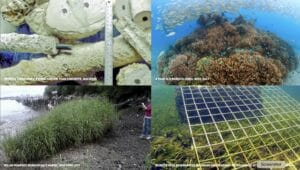Biorock regenerative living shorelines to clean coastal waters featured at UN Sustainable Floating City Roundtable
April 26, 2022, United Nations, New York City
Biorock living shorelines, regenerative natural biological ecosystems to filter and clean harbor and coastal waters, were highlighted in the United Nations Sustainable Floating Cities Roundtable on April 26 2022, which aims to help coastal cities adapt to global sea level rise.
All coastal cities and coastal populations are threatened by flooding from accelerating global sea level rise and by increasing storm wave strength caused by global warming. To reduce threats to coastal cities OCEANIX joined with United Nations Habitat to propose the world’s first sustainable floating city.
The first prototype floating city project is proposed for Busan, South Korea. The innovative design features novel Biorock regenerative systems that will make it the first city in the world that cleans the ocean instead if polluting it. It will do this with solar powered Biorock technology, using safe extremely low voltage direct currents to supercharge marine life that filters and purifies coastal waters from excessive nutrients, mud, pollutant chemicals, plastics, etc. that are choking natural ecosystems and causing fisheries collapse.
Seagrass beds and tidal salt marsh grasses growing on the sunlit upper submerged surfaces will trap dissolved nutrients from sea water and use them for lush plant growth that will be accelerated by solar-powered trickle charges. Fast growth of leaves above will be matched by prolific root growth underground, trapping carbon from the atmosphere and storing it in soil. Masses of mussels growing around plant stems will filter particulate matter from the water and help clarify it. The seagrasses and salt marshes will build up crab and shrimp populations. These will attract migratory wading birds in large numbers. The seagrass will provide shelter and food for sea fishes that will be attracted to the only natural habitat for them in the harbor, and will be visible to the public with submerged LED lighting.
Prolific marine life will grow invisibly, out of sight on the bottom and submerged sides of OCEANIX Busan. Mussels, sponges, tube worms, and other marine organisms will filter the water for organic matter to eat, consuming it or dumping it onto the sediment, clearing the waters. These living shorelines all around the perimeters and much of the dark bottom surfaces of the islands will be supplemented by the undersides of floating solar panel arrays helping power OCEANIX Busan, invisibly cleaning coastal waters. The total area of this ecosystem, of regenerative surfaces for each module will be 40,000 square meters. These will attract juvenile fishes in large numbers, which will be out of sight except to divers or underwater camera drones, but can be seen by the public via live streaming underwater webcams.
On the bottom Biorock anti-erosion reefs are planned as scour protection for the OCEANIX Busan pilings. Pilings cause scour and erosion around them, which affect their stability. Biorock reefs around the pilings will trap sand and mud, building up the bottom around them. The upper surfaces of these reefs will provide still more regenerative filter feeding biological communities cleaning bottom water, probably dominated by large sponges and tube worms.
OCEANIX Busan is the first coastal city that will clean the water around it, every coastal city in the world is the major local source of water pollution. If they all followed the OCEANIX Busan approach, resilient Biorock regenerative living shorelines could greatly improve coastal water quality and fisheries and regenerate natural coastal resources necessary for a sustainable Blue Economy that can adapt to, and reverse, global climate change.

Examples of Biorock technology that will be applied at OCEANIX Busan.